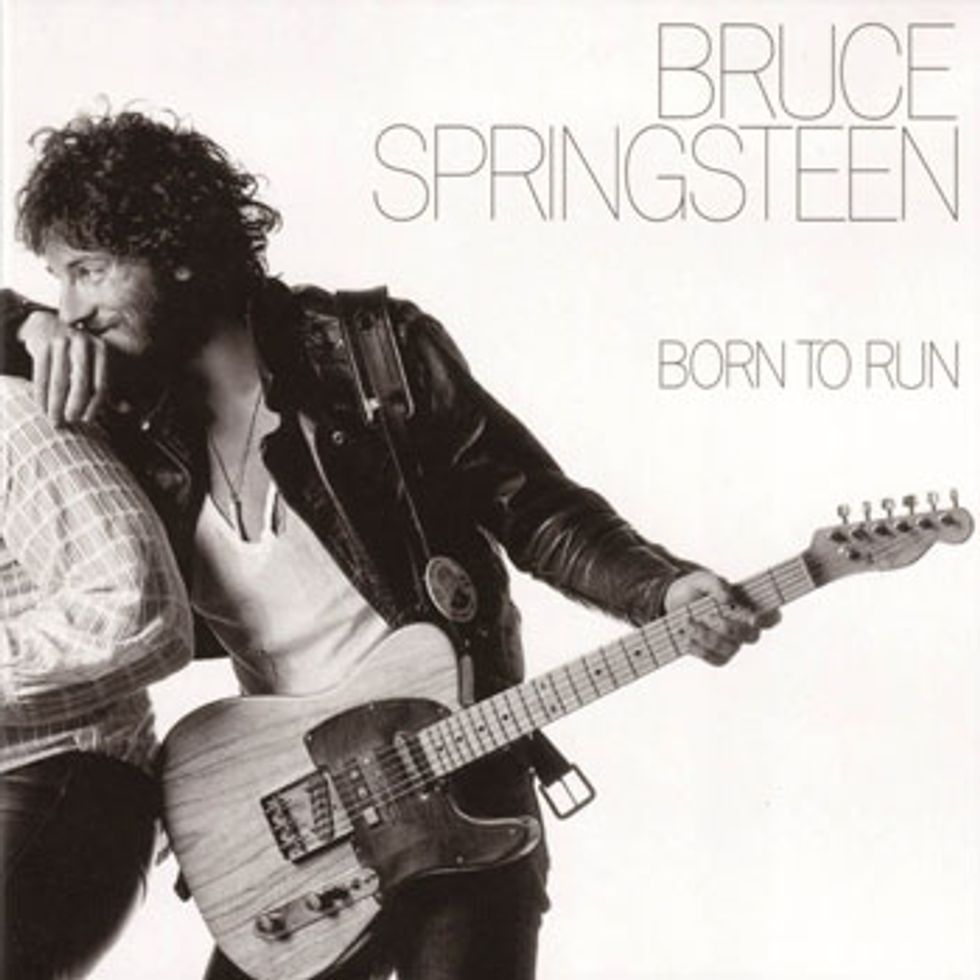
Bruce Springsteen and his heavily modified '50s Esquire on the cover of his 1975 classic, Born to Run.
After our brief exploration of the Esquire's history and tone [“Fender Esquire Basics," May 2012], we're ready to turn our attention to modifying this iconic guitar. If you're looking for ways to make the circuit more flexible or better suited to your sonic needs, you've come to the right place.
Now, I'll admit it took me some time to get comfortable with our first mod. It was so simple, I couldn't fully embrace it—at least at first: Simply connect the two pickup wires to the output jack, bypassing the switch and all the guitar's electronics. Solder the pickup's white (hot) wire to the tip of the output jack, and the pickup's black (ground) wire to the sleeve—that's it!
Before you accuse me of forgetting to take my meds or going completely insane, let me explain. When I received an Esquire from a customer requesting this mod, I thought, “That's crazy!" But after I did the mod, I had to keep the guitar in the shop for a few days before I sent it back. After playing it for a while, I concluded that an Esquire modded this way—running through a volume pedal and stompbox EQ—is a serious sonic weapon with tons of tone. (My personal choices are a George Dennis GD020 volume pedal and a Monte Allums-modded Boss GE-7 EQ.)
Sure, the control plate with the pickup selector switch and two knobs becomes merely cosmetic, and you don't have any options for shaping your tone directly from the guitar. But it only takes a short time to fall in love with this configuration, and you'll start using your fingers and hands more—exploring different damping techniques and ways to pluck the strings—to shape the tone. Because the guitar's electronics are bypassed, you hear the pure pickup tone, which is noticeably louder, more gutsy, and offers more high-end bite than the standard factory wiring.
This is a mod for the minimalist— someone who is looking for a pure tone. Sometimes less is more, so give it a try. If you don't like this mod, it only takes a few minutes to reverse it. Also, you can fine-tune this tone by varying the length and make of your guitar cable. A longer cable adds more load to the circuit and will bleed off some highend to ground. Also, a high-capacitance cable will bleed even more high-end to ground, so this is another area for experimentation. The external volume pedal gives you full control over your level, and if you need additional sounds, the stompbox EQ makes a very versatile and powerful tone control.
The Esquire's 3-way switch provides another area for modding—especially position No. 3. As you may recall from last month's column, in this position the pickup is routed through the volume control with the tone pot bypassed and a fixed “treble roll-off " capacitor/resistor network engaged instead. In stock form, this yields a very dark preset tone, which Leo Fender hoped would encourage guitarists to throw in some bass lines or even allow them to sub for a bass player in a band.
In a typical Esquire, we have three 0.05 μF caps and a 3.3k resistor. (To see the schematic for the original 1950 Fender Esquire, go to premierguitar.com and look for last month's Mod Garage column.) As you may remember from our countless Strat Mod Garage columns, experimenting with caps and resistors is a great way to explore sound and refine your tone.
In early-'50s Esquires, Fender used three 0.05 μF/150V paper-waxed caps made by Cornell Dubilier, plus either an Allen Bradley or Stackpole 3.3k/1W carboncomposition resistor with a tolerance of 5 percent. If you want a strictly vintage sound, these are the parts you should use, or at least approximate.
But you're not limited to vintage-style components. You can use a different type of cap for all three caps—paper-in-oil, ceramic, film/foil, silver mica, and Styroflex. Feel free to experiment and go wild. For the resistor, you can try metal film or carbon film as an alternative, and you can use smaller wattages to make it easier to place the resistor inside the control cavity. It's difficult to find the original paper-waxed, new-old-stock (NOS) capacitors, but the resistor shouldn't pose a problem.
Personally, I like 715P or 225P Orange Drop caps and metal-film resistors in Esquires. Similar to the original paperwaxed caps from the '50s, the P-series Orange Drop caps have a nice scooped midrange and provide the signature Fender tone we know from these guitars.
You may find it very challenging to stuff three 715P Orange Drop caps into a standard Esquire or Tele cavity. These caps are made to handle 600V and are fairly bulky. The 225P series makes an excellent alternative because they're noticeably smaller due to their 100V rating. The different voltage ratings of these caps will not make any tonal difference in a guitar, so don't worry. We'll continue next month with more Esquire mods. Until then, keep on modding!
Dirk Wacker lives in
Germany and is fascinated
by anything related to old
Fender guitars and amps.
He plays country, rockabilly,
and surf music in two
bands, works regularly as a
session musician for a local studio, and writes
for several guitar mags. He's also a hardcore
guitar and amp DIY-er who runs an extensive
website—singlecoil.com—on the subject.











![Rig Rundown: Russian Circles’ Mike Sullivan [2025]](https://www.premierguitar.com/media-library/youtube.jpg?id=62303631&width=1245&height=700&quality=70&coordinates=0%2C0%2C0%2C0)








